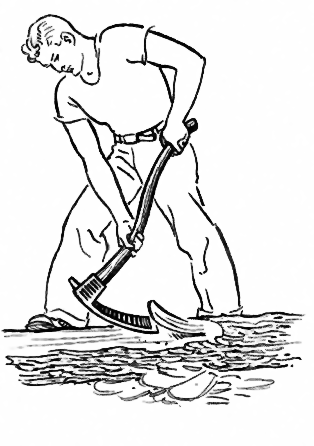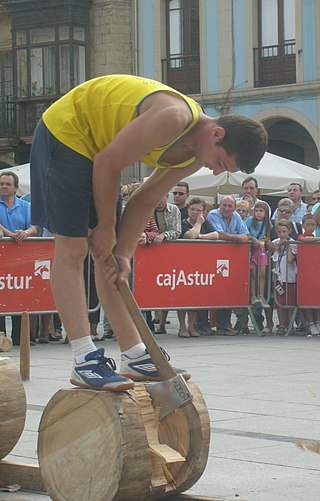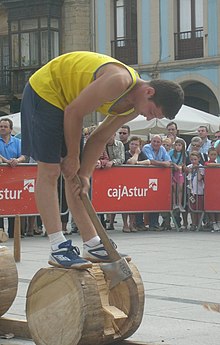
Lumberjacks are mostly North American workers in the logging industry who perform the initial harvesting and transport of trees for ultimate processing into forest products. The term usually refers to loggers in the era when trees were felled using hand tools and dragged by oxen to rivers.

An adze or adz is an ancient and versatile cutting tool similar to an axe but with the cutting edge perpendicular to the handle rather than parallel. Adzes have been used since the Stone Age. They are used for smoothing or carving wood in hand woodworking, and as a hoe for agriculture and horticulture. Two basic forms of an adze are the hand adze —a short-handled tool swung with one hand—and the foot adze (hoe)—a long-handled tool capable of powerful swings using both hands, the cutting edge usually striking at foot or shin level. A similar tool is called a mattock, which differs by having two blades, one perpendicular to the handle and one parallel.

Devonport is a city in northern Tasmania, Australia, located on the lands of the Pannilerpanner clan of the Palawa nation. It is situated at the mouth of the Mersey River. Devonport had an urban population of 26,150 at the 2021 Australian census.

Latrobe is a town in northern Tasmania, Australia on the Mersey River. It is 8 km south-east of Devonport on the Bass Highway. It is the main centre of the Latrobe Council. At the 2006 census, Latrobe had a population of 2,843. By the 2016 census, this had increased to 4,169. The locality is in the Latrobe Council area, but with a mere 0.1% in the Kentish Council LGA.

Woodsman is a competitive, co-ed intercollegiate sport in the United States, Canada and elsewhere based on various skills traditionally part of forestry educational and technical training programs. In North America, the sport currently is organized in five regional divisions: northeastern, mid-Atlantic, southern, midwestern, and western.

The Mersey River is a river on the north-west coast of Tasmania, Australia. The city of Devonport is situated at the river's mouth on Bass Strait.

David Foster OAM is an Australian world champion woodchopper, and Tasmanian community figure. He has held the World Woodchopping Championship title for 21 consecutive years, and is Australia's most successful athlete and possibly the only athlete in any sport in the world to win over 1,000 titles.
Articles on forestry topics include:.

Chainsaws and chainsaw operations have specific risk control methods.
John Edward Shewry MM, was a world champion woodchopper from New Zealand. Born in Stratford, New Zealand, he was one of 11 children of John and Elizabeth Shewry. The Shewrys were early settlers in Tahora in the Eastern Taranaki hill country, where they set to clearing a large block of land on Moki Road for pasture between the Makino and Waitaanga forests. The felling of timber dominated the lives of the Shewry family, and growing up in this setting clearly left a lasting impression on the young John Edward.

The Royal Hobart Regatta is a series of aquatic competitions and displays held annually in Hobart, Tasmania, Australia and is Tasmania's oldest sporting event. The regatta began in 1838.

The Lumberjack World Championships are held annually in Hayward, Wisconsin. The event began in 1960 and is held at the Lumberjack Bowl. There are 21 events for both men and women to compete for over $50,000 in prize money. Contestants come from the United States, Canada, Australia, and New Zealand. The events include sawing, chopping, logrolling, and climbing to test the strength and agility of over 100 competitors.
Aizkolaritza is the Basque name for a type of wood-chopping competition. They are a popular form of herri kirol in the Basque Country. Competitions are commonly held at most festivals, especially town festivals and usually involve at least two individuals or teams competing against each other.

An axe is an implement that has been used for millennia to shape, split, and cut wood, to harvest timber, as a weapon, and as a ceremonial or heraldic symbol. The axe has many forms and specialised uses but generally consists of an axe head with a handle, also called a haft or a helve.
The Stihl Timbersports Series is a series of woodsman or wood chopping competitions where the athletes compete in the use of axes and saws in manners typical for lumberjacks. It was founded in 1985, and currently includes six different disciplines, with both professional and collegiate divisions. The terms 'timbersports' and 'timber sports' are trademarked by Stihl Inc.
Brad De Losa is an Australian fitter who is a champion at forestry sports such as wood-chopping and sawing. In 2015, he set a new world record, cutting through four tree trunks in less than 58 seconds. In May 2017 Brad De Losa managed to win the Stihl Timbersports Champions Trophy for a third year in a row.

Jason Wynyard was a New Zealand champion woodchopper from Kawakawa. He won over a hundred world titles in the sport, including the individual world championship nine times. He holds the world record for single buck with a time of 9.39 seconds in 2007.
Stirling Hart is a Canadian professional lumberjack.

Ferry Svan is a Swedish professional woodchopper and logging sportsman, and the son of champion skier Gunde Svan. He is the first Swedish person to compete in a World Championship in logging sports, the first Swede to win a World Championship, and the youngest person to compete in logging sports as a Senior athlete. He has previously held four Swedish national records. He competes in the Stihl Timbersports Series.
Hot Saw is an event or discipline in logging sports. It is also used to describe the type of saw used in the event, a high-powered chainsaw.



















